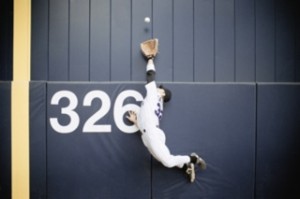June 11, 2013
Sports Vision
The eyes guide the body. If an athlete with a well-trained body is unable to use their eyes to their full abilities,
they are not performing at their maximum potential. Professional and weekend athletes have found that vision can play an important role in sports performance. It may be the one thing that keeps a good athlete from being an exceptional one. It also can be the all-important factor that pushes a good athlete into an elite athlete.
In addition to a routine eye examination, which should evaluate the refractive and health condition of the eyes, the following are visual skills that can be evaluated in a Sports Vision workup:
1. Visual Acuity: Clarity of vision (static visual acuity) is critical in all visual sports. This factor should be tested in addition to contrast sensitivity, which may be even more critical in athletic performance. Contrast sensitivity measurements give an indication of visual sensitivity to detail and how well the eyes see during different weather and lighting conditions. Dynamic visual acuity is a measurement of how clearly an athlete can see moving objects and should also be evaluated.
2. Eye Movement Skills: Two types of eye movements should be evaluated. Saccades are eye jumping movements when looking from one object to another. Pursuits are smooth eye movements which are important in tracking moving objects. The speed and accuracy of these skills should be tested.
3. Accommodation/Vergence: The ability to efficiently change eye focusing and eye aiming when looking between objects at different distances should be tested. Efficient accommodation and vergence abilities are critical for any athlete involved in a sport which requires visual awareness of objects or players at different distances from the athlete. The testing should also probe the athlete’s likelihood of visual judgment errors when fatigued or experiencing high levels of stress.
4. Depth Perception/Eye Teaming: Depth perception is the ability related to two-eyed aiming and should be evaluated at various distances and positions of gaze. These skills are critical in the athlete’s judgment of distance and speed.
5. Central/Peripheral Visual Recognition: This is a skill that measures the athlete’s accuracy and quickness in recognizing visual information and measures the response time to information in the peripheral field of view.
6. Eye-Hand-Body Coordination: These skills are critical in any fast moving sport. The speed and accuracy of eye-hand coordination and body movements in response to visual information should be tested. In addition, the visual factors involved in maintaining balance during athletic performance should be evaluated using a sequence of vision/balance tasks which simulate actual sports performance conditions.
7. Visual Concentration: This is the ability to focus your attention on the athletic task while filtering out peripheral distractions.
8. Visualization: Visualization involves picturing different parts of your activity in your “mind’s eye” while your eyes are seeing and concentrating on something else, usually the performance. Studies show that when you visualize yourself performing a particular activity, the muscles of the body actually contract. This is a form of actual sports training. Visualization can boost your confidence and aid in greater focus on your athletic goals.
If a weakness is found in any of the above areas, a Sports Vision enhancement or training program can be developed to improve these skills.
In addition to testing and training these visual skills, Sports Vision also encompasses providing custom designed and sports specific contact lenses and protective eyewear for the athlete.

